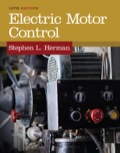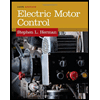
Electric Motor Control
10th Edition
ISBN: 9781305177611
Author: Herman
Publisher: Cengage
expand_more
expand_more
format_list_bulleted
Concept explainers
Question
Chapter 51, Problem 4SQ
To determine
Explain why electric braking is smooth and resilient.
Expert Solution & Answer
Want to see the full answer?
Check out a sample textbook solution
Students have asked these similar questions
BW=1MHZ
For Johnson-Nyquist Noise Generator (or Thermal Noise Generator), the device utilizes the
thermal noise that naturally arises from the random motion of electrons in resistors at a non-zero
temperature. The voltage is arising from thermal noise in two resistors of 80 and 120 Qat
Temperature T=290 °k:
1-Write the equations of v(t), 12(t), up on the circuit diagram of series and parallel connecti
2- Apply the equation v(t) to find Vrms for series connection scheme.
3- Find inrms for Series scheme
4- Find the Vrms for series scheme. By using i̟rms
√³(+)O
v²(t)
80 120
ww
R₁ R₂
Gi
G
if(t)
1/80 1/120
For Johnson-Nyquist Noise Generator (or Thermal Noise Generator), the device utilizes the
thermal noise that naturally arises from the random motion of electrons in resistors at a non-zero
temperature. The voltage is arising from thermal noise in two resistors of 80 and 120 Qat
Temperature T=290 °k:
1-Write the equations of v(t), 12(t), up on the circuit diagram of series and parallel connecti
2- Apply the equation v(t) to find Vrms for series connection scheme.
3- Find inrms for parallel scheme
4- Find the Vrms for series scheme. By using inrms
80 Q 120
ww
R₁ R₂
v²(t)
Gi
i²(t)
1/80 1/120
Vcc=-12 V;R1=33 kΩ;RC=1.8 kΩ;βDC = 150;RE=560Ω;R2=5.6 k Ω確定圖5-38中的I1、I2和IB。
課本給的答案A: I1=315μA;I2=288μA ;IB=27μA,請教我計算過程
Chapter 51 Solutions
Electric Motor Control
Knowledge Booster
Learn more about
Need a deep-dive on the concept behind this application? Look no further. Learn more about this topic, electrical-engineering and related others by exploring similar questions and additional content below.Similar questions
- Consider the following circuit, assuming the switch has been in the same position for a long period of time before t = 0: Vx L iL R3 R2 R₁ Is + Vo - コロ >Where Is = 100 mA,R=2202, R2 = 4702,R3 =4702,L= 1 mH. As indicated on the diagram, before t = 0, the switch is closed, after t = 0 the switch is open. 1. What are Ve and Vo before the switch shown opens (answer to within 1% accuracy)? Vx = V, Vo = V 2. What is the T of the RL circuit after the switch operates (answer to within 1% accuracy)? T= μs 3. Complete the derivation for the inductor current in (t) differential equation below by filling in the blank coefficients (answer to within 1% accuracy): diy(1) dt di (0) + iz (t)+ = 0 4. Hence or otherwise, find the time domain expression for Vo(t) (answer to within 1% accuracy): Vo(t)= exp(arrow_forward確定圖5-38中的I1、I2和IB。 Vcc=-12 V;R1=33 kN;RC=1.8 kN;βDC = 150;RE=560;R2=5.6 kN 圖 5-38arrow_forwardConsider the following circuit: Vs R₁ Vx ww C'₁ R2 Where Vs = 3.3 cos(2000t-10) VR:=2202 R2 = 1002,L=1mH, Ci = 22 nF, C2 = 47 nF N.B. We have been using cosine as the basis for our phasors. 1. What is the impedance of each of R, Ci, L (answer to within 1%): Z RI = +j Q Zci= +j QZL= +jQ 心 2. Complete the following KCL for node Vo, assuming current flowing out of the node is positive (answer to within 1%): 0= +j )+Vo/ +j0)+Vo/(0+j 回回回 3. Hence or otherwise solve for Vo in phasor form (answer to within 1% amplitude and 5 degrees of phase): Vo = ° V 回 4. Convert this phasor to a time domain expression for Vo(t) (answer to within 1% amplitude and 5 degrees of phase): Vo(t) = cos( t+ Vo 1arrow_forward
- is pf leading, lagging or neither?arrow_forward*please use pen and paper to show work (thank you!!!)* Design a synchronous binary up-counter using 4 negative edge-triggered JK flip-flops provided with a clock. The states (sequences) 1100, 1001 and 1000 are considered as unused states. (i) Draw the state diagram of the counter. (ii) Build the counter’s state table showing the synchronous inputs of the JK flip-flops as well. (iii) Using Karnaugh-maps, find the minimal sum-of-products (SOP) form of the equations for the inputs to the flip-flops; assume the next states of the unused combinations to be <don’t care states=. (iv) Draw the logic circuit of the counter.arrow_forwardSolve this problem and show all of the workarrow_forward
- Design a fuel-cell – Supercapacitor hybrid locomotive with 640 horsepower and a traveling range of 500 km per fully charged hydrogen tank, and consumption rate of 500 Wh/km. The fuel cell provides the driving range and supercapacitor captures the regenerative breaking energy to run the accessories. Assume fuel cell efficiency at 50%. 1hoursepower = 750 W Calculate the size (volume in liter) of a pressurized hydrogen storage tank at 700 bar pressure to deliver the traveling range for the vehicle. Fuel cell voltage at the cell level is 1V. Calculate the volume of solid-state hydrogen storage tank for the vehicle if the solid NaAlH4 is used as a hydrogen storage material. The density of NaAlH4 is 2.8 g/cm3. Atomic weights: Na=23g, Al=27g, and H=1g Calculate the total amount of platinum catalyst loading inside the fuel cell stack, and cost of catalyst if Pt cost as $30/g. Assume catalyst loading on the anodes at 0.02mg/cm2 and 0.04mg/cm2 on the…arrow_forward4. Design an operational amplifier circuit to implement the following mathematical equation. 0.25 dv dtt dvo + ·+ V₁ = Vi dtarrow_forwardsolve and show workarrow_forward
- Problem 4 Consider a unity (negative) feedback system whose open-loop transfer function is given by K(s+1)(s+2) G(s): s(s +10) Assume K = 1. (a) What is the type of the system? (b) Find static position error constant Kp, static velocity error constant Ky and static acceleration error constant Ka (c) Find the steady state-error of the system for following each of the following inputs. (i) (!!) t³ 1(t) (t+2) 1(t) (d) Find the range of K, for which steady-state error of the system for ramp input will be less than 0.05?arrow_forwardAn inner-city metro-bus weighs approximately 10,000 kg including passenger loads, travels 500 km per fully charged battery, and consumes 420 Wh/km. Design a lithium-ion battery pack for the metro-bus using newly developed cells made of silicon anode and lithium manganese-iron phosphate (LMFP) with formulation of Si // 4(LiMn5Fe0.5PO4). The cell average voltage is 3.5V and its capacity 4Ah. The nominal battery pack voltage is 350V. Report the battery pack configuration: Calculate the amount of silicon and LMFP cathode that is required for a single cell at 4Ah capacity. Atomic weight of elements in gram: Si=28 , Li=7, Mn=55, Fe=56, P=31, and O=16. If the building block cell is designed in a cylindrical format (2cm diameter and 10 cm height), calculate the energy density (Wh/lit) and specific energy (Wh/kg) at the cell level and at the battery pack level. Assume cell weight 100g, and cells are arranged in two layers in the battery pack with top…arrow_forwardProblem 2 Consider the following feedback control system. (i) (ii) K(s+2) s(s + 1)(s+3) 5+6 5+7 Use Routh-Hurwitz criterion to find the range of K for which the closed-loop system is stable. Using the Routh table from part (a), find the range of K for which the closed-loop system will have one pole in the ORHP and rest of the poles in the OLHP. This implies there will be only one sign changes in the 1st column.arrow_forward
arrow_back_ios
SEE MORE QUESTIONS
arrow_forward_ios
Recommended textbooks for you
